In Part 1: CASUAL JAUNTS THRU SWEDEN and DENMARK, excellent food seduced our senses and teased our palates, from the early morning buffet at Nobis Hotel Stockholm to the many restaurants we visited. Eating did not encompass all our time, so read on to see how we worked off all those calories!
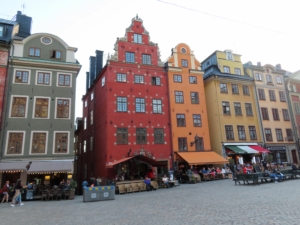
Images of these colored buildings in Stortorget Square in Gamla Stan, the Old Town of Stockholm, adorn most souvenirs and postcards.
WHAT WE DID:
A short distance from our hotel and needing to kill time before being able to check in, we came across The Hallwyl Museum. We were initially drawn by the fancy outdoor garden restaurant that led into a courtyard. Then we spotted a wide staircase that led from the left of the unexpected alleyway. We walked up from curiosity, but it was the rich woods, marble colonnades, patterned floor tiles, and green statuary of lithe dancers gracing the frontage of the burnished wood stairway railings that beckoned us to pay the entrance fee.
The mansion was built in 1893-1898 for Wilhelmina and Walther von Hallwyl as their estate home. Although the elegant interior designs by architect Isak Gustaf Clason reflect diverse historical periods throughout the three floors, the house was quite modern for the times. Mrs. Hallwyl intended for the home to become a museum after their deaths, so she and her staff of assistants and experts catalogued every object, from kitchen equipment, personal possessions, to works of art. Each item was numbered, photographed, and meticulously described by Wilhelmina. Special glass cases and shelving were ordered and organized to her specifications. More than 300 pieces of glass, metal, ceramics, and even clothing representing Art Nouveau styling are displayed throughout. A 78-volume catalogue was privately printed in an edition of 110 copies. The Hallwyl Museum contains one of Sweden’ s largest cultural-historical collections. Because the museum was originally created as a private residence, there are no elevators. In 1920 the house with all its contents was donated to the nation, and the museum officially opened in 1938.
Only someone who realizes there is so much to see and do and not enough to accomplish it all would go to three museums in one day. As we did.
Tip 5: There are 89 museums listed on the city map of Stockholm. We ended up visiting maybe half a dozen, each specific to the region, but undoubtedly the number one must-see attraction in the city is the VASA Museum.

A model of VASA shows the colors as originally painted.
The enormity of the 17th-century warship VASA that was salvaged after 333 years submerged on a seabed and then preserved with hundreds of its original carved sculptures is overwhelming to the senses. Ornate artwork on the ship, dulled by being waterlogged, has been replicated with their original colors (based on surviving bits of paint or details in craftsmen’s diaries and letters to loved ones) on full-standing statues and wall hangings. Maps indicate where each piece had been positioned.
Documentary videos explain why King Gustav II Adolf (1594-1632) hired Dutch master shipwright Henrik Hybertsson, a man of great repute, to design the massive and absurdly ornate warship, and why it went so wrong. First, the King demanded a second tier of cannons be mounted around the ship. Second, Hybertsson did as ordered, but because he didn’t draw out his design plans, the ship was built without the ballast being properly balanced to counter the weight of the cannons, something Russ pointed out immediately upon seeing displayed models and sketches.
The VASA sank on its maiden voyage on August 10, 1628, after only travelling about 1000 meters into the Stockholm harbor when a small wind gust blew and water rushed into the open gun ports. Many lives were lost. The films, shown in multiple theaters with times posted for which language it was in, noted that while some leaders were put on trial, no one was ever found responsible. Hybertsson died before the trial.
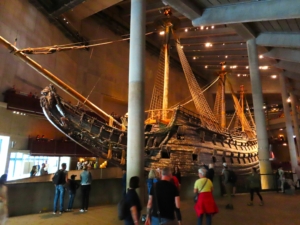
VASA was salvaged from the bottom of the seabed where she sank.
VASA is not a museum to skip through hastily. The details of the ship, its crew, and the history of its construction are stunning. Because the cavernous building occupies multiple floors and is so popular with tourists and locals alike, expect a crowd. I recommend eating in the café on the second floor. Russ and I shared an enormous plate of Swedish meatballs and mashed potatoes that was both delicious and reasonably priced. A complimentary basket of sliced bread sits on an island just past the cafeteria line but is easy to overlook. This was the first time I had ever had elderflower soda. Not oversweet and quite refreshing after the warm museum.
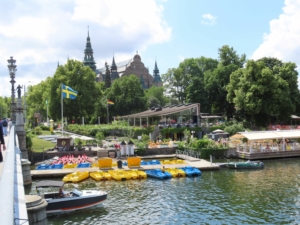
Stockholm Bay with Nordisk Museum looming tall in the background.
VASA Museum’s location was once the King’s exclusive hunting garden. In our walking tours we also saw the King’s reflecting pool, a football field-sized pool surrounded now by green space, trees, and fountains.
We had walked by The Nordiska Museet (Museum) enroute to VASA. The exterior of the building intrigued us, so we popped in afterwards. The museum examines the lives, homes, and clothing of Nordic people, from the 16th century to today. We watched an excellent temporary interactive exhibit on climate change’s impact on the Nordic way of life.
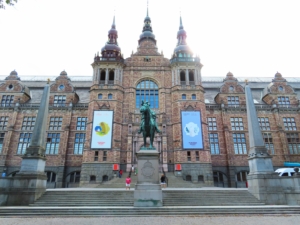
Nordiska Museet holds exhibits on climate change, traditions of daily life, and fashion influenced by French designers.
The exhibit that most took me by surprise was “Paris of the North.” It showcased Parisian Haute Couture’s Nordic Connections. A high-fashion department store called NK established the French Couture Atelier. The mannequin-modeled clothing shows the evolution of fashion from 1902 to 1966, displaying haute couture’s chronological rise and includes original designs by names such as Coco Chanel, Cristóbal Balenciaga, Madeleine Vionnet, and Christian Dior. There are video montages from runway shows with some of the same displayed dresses, gowns, and coats. I wanted to drool longer, but the room was stuffy, and we were tired.
Tip 6: Museums are not air conditioned. The air, especially when crowded with guests, can be warm and still.
ABBA The Museum was our third museum of the day. Russ and I have watched both versions of “Mamma Mia” movies several times and have sung along to many of their famous tunes (but not in my not-ready-for-public voice), so hey, we were fans, right? The museum has many interactive components: from displays of the costumes they wore for performances, videos of when they won the Eurovision Song Contest in 1974 with “Waterloo”, and backgrounds on who each were in their performing careers before forming ABBA. There was an animatronics stage show of them singing and documentary footage of how that was produced.
Of course, you could buy replica clothes, accessories, and music in the gift store. Russ was less impressed by the exhibit than me. I think tiredness after walking all day through three overly warm museums played a huge part in his lack of enthusiasm. Somehow, he thought there would be more clips of them singing. Anyway, if you’re an ABBA fan, this is a fun ode to their continuing adoration, especially by Swedes.
Sven, a semi-retired hematologist and current infectious disease specialist, walked us around Stockholm, pointing out the significance of buildings, telling us of Swedish daily life, and taking us to locations unlikely known to most tourists. For instance, he noted that about 40-50% of Swedes own their own residence. More Swedes live in the city than elsewhere. Apartment buildings, such as the one in which he lives, are typically four stories high with perhaps four apartments on each floor. The building is owned by an association of the owners. At the bottom of most apartment buildings is a one-car garage, which is rented to a private enterprise. The association receives a percentage of the money from that business rental.
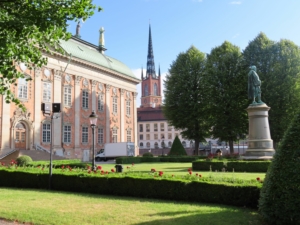
The King’s House
He pointed out the Knight’s House, a large building gated off from the public in Stortorget (the Grand Square) in Gamla Stan, the oldest square in the old town of Stockholm. On top of the Knight’s House roof are three sculptures on each side and on the roof front. Built between 1641 and 1674, the Knight’s House is a center for parliamentary assemblies and administrative services. Sven is an honored member. Other notable historically significant architectural structures in Stortorget are the Stock Exchange Building, the Nobel Museum, and the Nobel Library. Many souvenirs and postcards feature the colorful buildings of Gamla Stan and it is here where an abundance of tourist shops hawk their wares.
Tip 7: Metro Stockholm has about 50 neighborhoods. Old town is an area of about 10 neighborhoods. You can’t walk to all of them easily, but buses and trams run regularly.
Tip 8: We rode the subway with Sven to get around the city easily. What impressed us was how far down the escalator travelled to get to the platforms and that each area of the subway station walls and floors were uniquely themed with whimsical colors and materials.
One of the bus stops is right across from Ahlens, an enormous department store chain that Sven swears has the best fresh fish market in Stockholm. He said the foods and goods stocked in Ahlens are influenced by immigrants and by Swedes who travel extensively. The store’s goods are not catering to tourists’ tastes. One of the products he buys there is ransom olive oil with infused garlic. We did an olive oil taste test of the ransom with garlic: it has a distinctive peppery bite. Once I returned to the States, I tried to find some and have so far not succeeded.
Sven also pointed out all the varieties of cracker bread (knäckebröd), typically a mixture of rye flour and oats. It’s often in restaurant’s breadbaskets and in grocery stores. Each we tried had its own texture and taste.
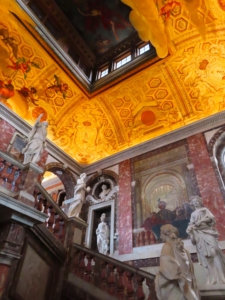
Statues and paintings adorn multi-level staircases in Drottninghom Castle.
Stockholm is spread across 14 islands. We rode on the Stromma ferry boat about an hour to get to the island of Lovon in Lake Malaren, to a suburb of Stockholm called Drottninghom. Although home to the Queen’s Castle, in reality, the Drottningholm Palace has been the royal family’s permanent residence since 1981. Quick backstory: Nicodemus Tessin the Elder, and later his son, designed the Baroque palace, which was gifted to Queen Lovisa Ulrika in 1744. She added rococo elements to the décor. In 1770, the palace was “bleached and plastered” in white. The palace, along with Drottningholms Slottsteater and Drottninghoms Slottspark are part of UNESCO’s World Heritage sites.
We walked past the park to visit the castle. Like many of the castles Russ and I have viewed in many European countries, the preserved (or replicated) furnishings and décor are showcased in bed chambers, libraries, statues, pottery, and fountains. In this castle, I noted tapestries made of leather skins from large animals, something I had not seen before. The drawing room features large portraits by David Klöcker Ehrenstrahl, a Swedish nobleman and portrait painter. There were many paintings by him and what struck me was how many portraits representing a succession of kings all resembled one another in pose, style, long dark curly hair, and attitude. They could have all been the same man except the portraits spanned generations and reflected attire of the times.
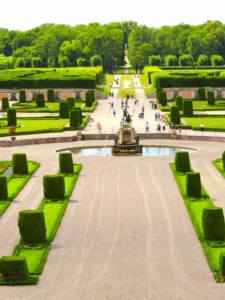
A small portion of the gardens behind Drottninghom’s Castle.
We really wanted to take the backstage tour of Drottningholm Slottsteater, one of the oldest theaters in the world still actively in use. Summertime ballets and operas still attract celebrity performers and international audiences. Designed by C.F. Adelcrantz in 1764, it still bears original décor and functioning stage machinery. The backstage tour given in English was at 2 pm and by the time we decided to buy the tickets, the tour was sold out. At least we were able to browse the gift store!
Russ and I love walking around theme parks and have had season passes for Disney, Universal Studios Resorts, and Sea World, so when Sven offered the opportunity to visit Skansen, a living theme park that recreates 700 years of Sweden’s cultural heritage, was a no-brainer. The park is a cross between a children’s petting zoo, a recreated village where period-costumed artisans demonstrate (and sometimes sell) traditional crafts, and an edutainment center. In fact, the Baltic Sea Science Center has more than five levels of displays that discuss past and current research, along with giant aquariums.
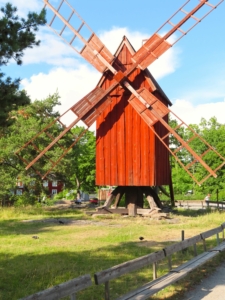
A windmill at Skansen, a living theme park showcasing 700 years of Sweden’s cultural heritage.
Small bakeries specialize in traditional treats one has for fika. Fika is a word used to mean coffee break. Fika is also the name for a bun-shaped cinnamon or cardamon roll eaten while having a coffee break. Activities vary seasonally. Skansen hosts summertime open-air concerts, dancing, and festivals. Wintertime there are sports contests, more festivals, and a Christmas market from late November into December that has occurred since 1902. I insisted on buying our grandson an all-wooden yoyo after watching an elderly costumed shopkeeper gleefully swing one more expertly than I ever could. Russ was fascinated in the vintage print shop and watching the gigantic pieces of machinery used in the furniture shop. You could easily spend the day there and never see it all, no matter the time of year.
THE EXPRESS TRAIN FROM STOCKHOLM TO COPENHAGEN WAS ANYTHING BUT
We had been advised that express train tickets on Kundservice from Stockholm to Copenhagen, Denmark sell out quickly, but aren’t even offered for sale until three full months prior to the date of the trip. We were also advised to buy first class tickets, which would come with a wonderful meal for the 5-1/2-hour direct journey aboard the new smooth-riding, WIFI automatic, express train. A week before that three-month availability, Russ wanted to scope out the process. When he logged on, he discovered there were only two first class seats still available at the time and day we wanted to travel. Score!
Here’s the reality. The always-on-time train was about half an hour late. Instead of a new train, we got one they must have pulled from storage. Worn seats, bumpy ride, stuffy and the WIFI was sporadic. The meal was composed of some type of mystery meat and inedible sides of salad and a dessert even Russ wouldn’t eat. No one mentioned there were bottles of water sitting on a back table we could have. The toilet seat in the first-class cabin was broken and lay on the floor. The sink’s water didn’t turn on and there were no paper towels. I made a mention to the one train person I saw twice during the entire trip, and she shrugged and said she didn’t know anything about it. I was told to make my way to the next train car if I needed to use a toilet.
Our direct train to Copenhagen made at least half a dozen stops. No explanation was given. Other passengers who had made this journey before were just as confused. Then the train stopped in Malmo (Sweden) and we were told to get off. To go to Copenhagen, we would have to take another train. Over a five-minute period, we were told to take two different trains in two different areas, with the final answer being a question mark to all around us. At this point, we were tired, hungry, schlepping our two large bags and our carry-ons, and frustrated. The Swedish train personnel were terse to the point of rudeness when we asked questions. Called our friends, Else and Erik Kaaber, to say what was happening as they were meeting us. At this point, we had no idea what time we would arrive, or where.
Malmo was busy with rush hour train customers. There was no possibility we’d be able to get on the first train. Only by asking others did we discover the train would go first to Copenhagen Airport, Kastrup, and then make a few more stops before getting to Copenhagen Central Station. Locals told us the train trip should take 20-25 minutes. It was 45. Once we finally arrived on this newer-styled train in Copenhagen Central Station we had to depend on our friends to find us to be sure we didn’t leave by the wrong exit, a far distance from where they had parked.
In Part 3: CASUAL JAUNTS THRU SWEDEN and DENMARK, we leave behind the active life buzzing around Stockholm and the trying experience of the Kundservice express train that was anything but, for the adventures awaiting us for our third visit with our longtime Danish friends.
www.ahlens.se/varuhus/stockholm-city?
www.hallwylskamuseet.se/en/visit-us/
www.kungligaslotten.se/english/royal-palaces-and-sites/drottningholm-palace.html
www. https://www.nordiskamuseet.se/
Karen Kuzsel is a writer-editor based in the Orlando area who specializes in the hospitality, entertainment, meetings & events industries. She is an active member of International Live Events Association and Meeting Professionals International and is now serving on the 2022-2023 MPI Global Advisory Board for Small Business Owners. She is a member of the Society of Professional Journalists. Karen writes about food & wine, spas, destinations, venues, meetings & events in her blog, Hotel Happenings & Program Promotions. A career journalist, she has owned magazines, written for newspapers, trade publications, radio and TV. As her alter-ego, Natasha, The Psychic Lady, she is a featured entertainer for corporate and social events. Karen@KarenKuzsel.com; www.KarenKuzsel.com; www.ThePsychicLady.com; @karenkuzsel; @thepsychiclady. She is also active with Experience Kissimmee CVB and Wedding Venue Map. Food photos for this series by Karen Kuzsel. All other photos by Russ Wagner, a retired government planner/builder who has a passion for historic architecture, wine, trains, travel and taking photographs.
